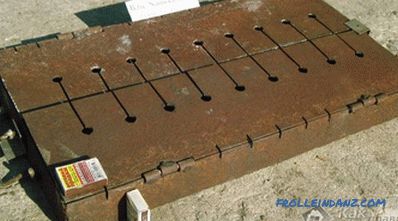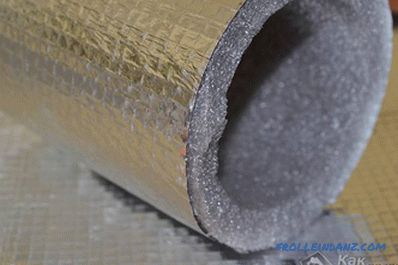Any suburban economy, which includes a dwelling house, a bathhouse, and other ancillary structures, cannot do today without a properly equipped sewage system designed for the discharge and disposal of human waste. In this article, which we offer to your attention, we will try to tell you about how the sewerage of a country house is mounted with your own hands, taking into account all the requirements for its arrangement.
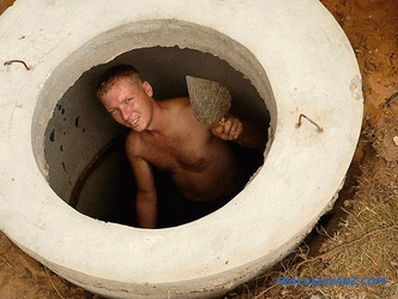 A septic tank made of concrete rings
A septic tank made of concrete rings
Despite the abundance of offers on the market for such services, many users prefer to engage installation of sewer network independently. And indeed, the technology of manufacturing an extensive system of collecting waste and sewage is quite simple, which allows its development by anyone who does not do it professionally. Such an approach makes it possible to dispense with the involvement of outside workers, which, naturally, reduces the costs associated with its arrangement.
Waste collection system
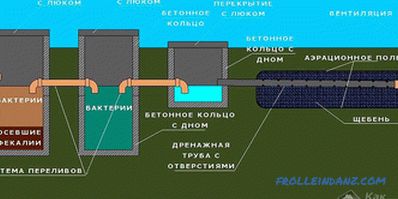 The principle of operation of the septic tank
The principle of operation of the septic tank
Modern sewage system - This is a whole complex of equipment, which includes not only the devices for collecting sewage, but also pipelines and special accumulators of waste (septic tanks).
The main functional purpose of such complexes is the collection of human waste (including waste water) at the points of their formation and subsequent transportation to the place of final or partial disposal.
Sewage installation of a country house should be carried out taking into account basic technological and environmental requirements. The sewage system should contain the following mandatory elements:
- special trays for waste collection;
- an extensive network of pipelines or canals through which waste is transported to the septic tank;
- the sump itself, designed as a sump or septic tank.
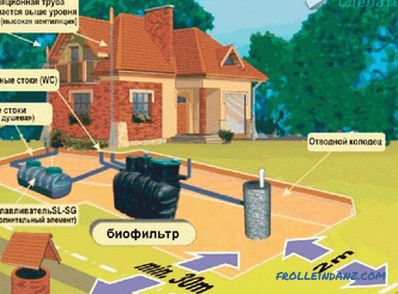 Sewerage scheme on the site
Sewerage scheme on the site
The installation of sewage in its own farm should be made according to a clearly designed plan, since any deviations from the standards can lead to violations in its work (the formation of blockages, for example). In this case, there is a danger of contamination of terrain with fecal waste, which is unacceptable if there are sources of drinking water near the house.
External contour
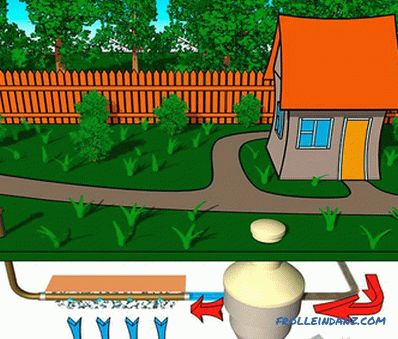 Path of passing the drain
Path of passing the drain
To the so-called external sewer contour Carry the piping system to ensure the natural movement of waste from the point of collection (tray) towards the cesspool or septic tank. This way of organizing the collection of sewage is called drainage. In some cases, the transportation of waste through the pipes to be carried out under pressure (pressure) created with the help of special pumping equipment included in the system.
Based on the above, at the design stage, it will be necessary to clearly define how the waste will be delivered to the sump (by natural flow or under pressure). From this circumstance will depend on the location of the settling tank (drainage well), as well as its depth.
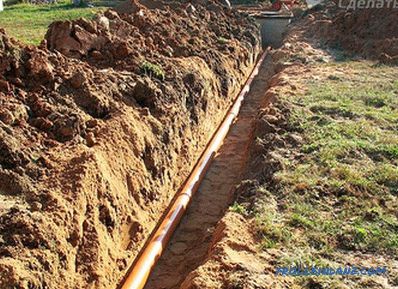 The slope of sewage pipes
The slope of sewage pipes
It goes without saying that when using the first of these options, the level of disposition of the cesspool pit (septic tank) is chosen below the level of the pipeline route, which provides the required slope in the direction of the assembly. In the second variant of the delivery of wastewater to the sump, carried out by means of a pump, the level of sewage installation (including its individual components) is not critical.
The location of the pipe laying route in this case is practically unlimited, so that the latter can be chosen on the basis of the convenience of organizing earthworks. The only technological requirement for pipe laying is that the angle of their bending always exceeds 90 degrees. Compliance with this requirement significantly reduces the likelihood of blockage. When choosing the optimal location for the waste collector, the previously noted requirement should be fulfilled (no closer than 5-7 m from the residential building).
Installation of the drainage system
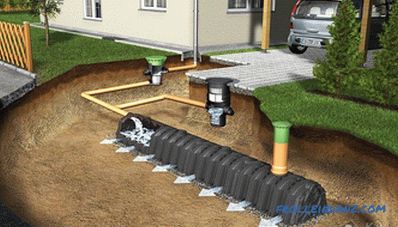 Drainage systems
Drainage systems
To the installation of a drainage system on a suburban plot usually start upon completion of the construction of the walls and roof of the main residential structure.
The following sequence of assembly operations should be observed during the work:
- First of all, a trench is pulled out under the pipes laid from trays or other waste collectors in the direction of the septic tank. At the same time, the possibility of the natural movement of effluent through the pipeline is ensured by its slight slope (2-2.5 cm per 1 running meter).
- Then the bottom of the prepared trench along its entire length is covered with a sand pillow.
- After that, it will be possible to start laying the pipe line, at the end of which the junction of the pipeline with the sump is sealed. For these purposes, you can use sealant.
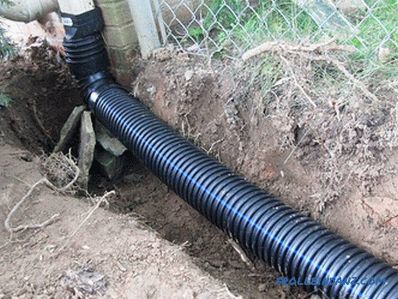 Laying the drainage system
Laying the drainage system
When laying pipes of different materials you will need to consider the following recommendations :
- Polypropylene pipes should be installed in special concrete boxes protecting products from mechanical damage. But PVC pipes can be laid directly in the soil (without using a special protective casing).
- The depth of the location of the pipe sewage is chosen based on the well-known requirement for laying waste communications, which must be above the freezing point of the soil in the area. For central Russia, this indicator is selected from a range from 1.2 to 1.4 meters.
- In the event that the winters in your region are very cold - additional insulation of the pipeline will be required using any suitable insulation material for this purpose.
- Now it remains to put the whole system together.
Construction of the cesspool
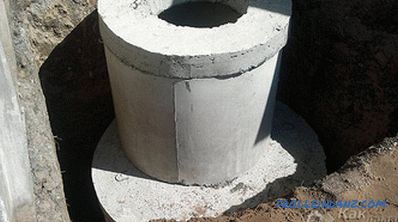 Cesspit from concrete rings
Cesspit from concrete rings
The most common type of autonomous waste collector is a conventional cesspool. The principle of operation of such a sump is very simple and consists of the following. In the process of accumulation of sewage entering the pit through the sewage system, the light fractions contained in them are gradually utilized by infiltration into the soil. After some time, when only heavy fractions remain in the pit, the latter are removed from the septic tank with the help of the appropriate equipment (as a rule, special waste-recovery machines are used for this purpose).
The lowland is the most convenient for placing such a waste collector, which greatly simplifies the subsequent installation of the drainage system. When sampling a suitable place for it, it is also necessary to provide for the possibility of preparing a small driveway for an as-suction vehicle.
Before starting work, you should familiarize yourself with the requirements of the epidemiological standards governing the allowable volume of waste pits (as a rule, this indicator is selected based on 0.6-0.7 m³ per person), as well as the distance from residential buildings and drinking water sources. In addition, certain restrictions are imposed on the materials used for the arrangement of such structures.
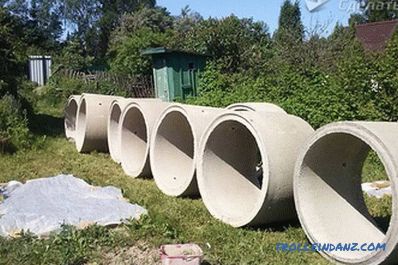 Concrete rings
Concrete rings
When choosing these materials, most users assume the availability and reasonable cost of the products used for the formation of the walls of the sump. In this case, preference is most often given to ready-made industrial structures, such as reinforced concrete rings, for example (diameter is about 2 meters, height is about 1.2 meters).
When carrying out excavation work, the following details should be remembered:
- Preparation of the excavation pit for reinforced concrete structures is carried out taking into account a small allowance in diameter, which provides ease of mounting the rings and the possibility of placing a layer on them waterproofing.
- In the course of work, the calculated depth of the well can be slightly adjusted, which is explained by the requirement for the location of the upper ring cut slightly below the ground level (this allows using a standard concrete slab with a hatch as a floor).
- Before laying the first ring, the bottom of the excavation is first reinforced and then concreted. Between the rings are fastened with special fittings, after which the gaps between them are sealed with mortar.
We recommend reading:
- septic tanks for giving with own hands from European cubes;
- than to defrost a sewer pipe in a private house.
You can watch the video on the arrangement of the sewage system below.
Video
This video is about the sewage system in a country house:
